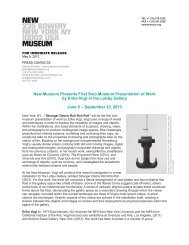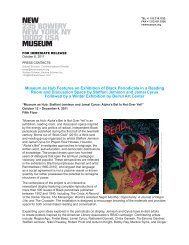The Body is a Machine
The Body is a Machine
The Body is a Machine
Create successful ePaper yourself
Turn your PDF publications into a flip-book with our unique Google optimized e-Paper software.
they become ind<strong>is</strong>tingu<strong>is</strong>hable from actual humans in our<br />
memories and dreams.<br />
For the contemporary individual, of course, social interactions<br />
that take place in the digital realm further complicate<br />
the relationship between organic and artificial bodies. Here,<br />
the d<strong>is</strong>tinctions between real and simulated, past and present,<br />
living and dead, are demonstrably blurred. <strong>The</strong> result<br />
<strong>is</strong> a liminal reality where hybrid states of being coex<strong>is</strong>t and<br />
communicate fluidly, and where the images, thoughts, and<br />
memories of these states accumulate and overlap. Seth Price<br />
has been concerned with the types of bodies and spaces that<br />
can be built from the detritus of the digital age. Price’s Koln<br />
Waves/Blues (2005/2008) <strong>is</strong> one of a number of works by<br />
the art<strong>is</strong>t that manipulates a commercial video clip of rolling<br />
ocean waves. Transferred to 16mm film, the image becomes<br />
otherworldly and entirely artificial. Its commercial origins are<br />
erased and it becomes a spectacular non-space, similar to<br />
the appropriated sublime landscapes of lightning storms and<br />
nuclear explosions seen in the paintings of Jack Goldstein.<br />
It’s hard not to imagine these types of spaces as documenting<br />
a netherworld of the digital realm—where the ghosts<br />
of machines wander apocalyptic landscapes, communicating<br />
with each other and with whatever programs preserve the<br />
individuals who built them.<br />
1. Philippe Parreno, “<strong>The</strong> Writer,” in Philippe Parreno: Films 1987–2010, ed.<br />
Karen Marta and Kathryn Rattee with Zoe Stillpass (London: Serpentine<br />
Gallery and Koenig Books, 2011), 162.<br />
2. Fritz Kahn, “Man, <strong>The</strong> Most Complicated <strong>Machine</strong>,” in Berliner Illustrirte<br />
Zeitung, 1926.<br />
3. Michelle Kuo, “Everything Goes: An Interview with Robert Breer,” in<br />
Artforum, November 2010, 218.<br />
4. Claes Oldenburg, “Passages: Robert Breer,” in Artforum, January 2012, 33.<br />
5. Ovyind Fahlstrom and Ulf Linde, Claes Oldenburg: Skulpturer och teckningar<br />
(Stockholm: Moderna Museet, 1966).<br />
6. Julia Peyton-Jones and Hans Ulrich Obr<strong>is</strong>t, “Interview with Mark Leckey,”<br />
in Mark Leckey: See, We Assemble, ed. Kathryn Rattnee and Mel<strong>is</strong>sa Larner<br />
(London: Serpentine Gallery and Koenig Books, 2011), 37.<br />
*<strong>is</strong> essay previously stated that Turing underwent Reichian Orgone<br />
therapy. e therapy that Turing underwent was known at the time as<br />
“organo-hormone” therapy and was not connected to “Orgone therapy.”<br />
We apologize for th<strong>is</strong> error.<br />
17




